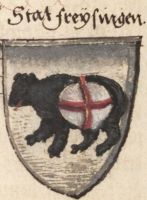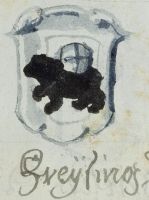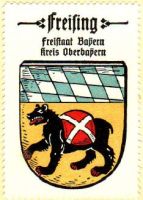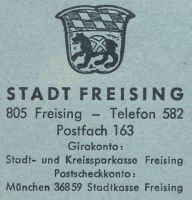Freising: Difference between revisions
Knorrepoes (talk | contribs) m (Text replacement - " / Arms" to "/Arms") |
Knorrepoes (talk | contribs) No edit summary |
||
| Line 22: | Line 22: | ||
The arms show in the upper part the arms of Bayern. Freising was the capital of the free State of Freising, ruled by the Bishops of the city. In 1803 the State was abandoned and the territory was incorporated into Bayern. The chief of Bayern appears first in 1811. The bear in the lower part is known since 1340. On the oldest seal the bear is seen between two towers. Above the gate the arms of the Bishops appear, a crowned Moor's head (see Freising District). The bear and the head represent St. Corbinianus, a 7<sup>th</sup> century bishop of Freising. The towers were removed from the seals and arms in the 16<sup>th</sup> century, since 1696 the small shield was also removed. From 1696-1811 thus only the bear was used. | The arms show in the upper part the arms of Bayern. Freising was the capital of the free State of Freising, ruled by the Bishops of the city. In 1803 the State was abandoned and the territory was incorporated into Bayern. The chief of Bayern appears first in 1811. The bear in the lower part is known since 1340. On the oldest seal the bear is seen between two towers. Above the gate the arms of the Bishops appear, a crowned Moor's head (see Freising District). The bear and the head represent St. Corbinianus, a 7<sup>th</sup> century bishop of Freising. The towers were removed from the seals and arms in the 16<sup>th</sup> century, since 1696 the small shield was also removed. From 1696-1811 thus only the bear was used. | ||
<gallery widths=250px heights=200px perrow=0> | |||
| | File:Freising1500.jpg|alt=Wappen von Freising/Arms of Freising|The arms around 1500 | ||
File:Freising16.jpg|alt=Wappen von Freising/Arms of Freising|The arms in a [[:Category:Windhag city arms|16th century manuscript]] | |||
File:freising.hagd.jpg|alt=Wappen von Freising/Arms of Freising|The arms by [[Otto Hupp|Hupp]] in the [[Kaffee Hag albums]] +/- 1925 | |||
File:3030.aba.jpg|alt=Wappen von Freising/Arms of Freising|The arms in the [[Abadie]] albums | |||
File:Freising60.jpg|alt=Wappen von Freising/Arms of Freising|Municipal stationery, 1960s | |||
File:Freisingp1.jpg|alt=Wappen von Freising/Arms of Freising|The arms on a special cancellation 1983 | |||
</gallery> | |||
{{media}} | {{media}} | ||
Revision as of 12:20, 7 September 2022
This page is part of the German heraldry portal |
Heraldry of the World |
|
German heraldry:
|
Selected collector's items from Germany:
|
FREISING
State : Bayern
District (Kreis) : Freising
Additions : Haindlfing, Itzling (partly), Sünzhausen, Tüntenhausen; 1978 Attaching, Pulling
| German | Unter Schildhaupt mit den bayerischen Rauten in Gold ein schreitender schwarzer Bär, der auf dem Rücken ein mit silbernen Bändern verschnürtes rotes Bündel trägt. |
| English | No blazon/translation known. Please click here to send your (heraldic !) blazon or translation |
Origin/meaning
The arms show in the upper part the arms of Bayern. Freising was the capital of the free State of Freising, ruled by the Bishops of the city. In 1803 the State was abandoned and the territory was incorporated into Bayern. The chief of Bayern appears first in 1811. The bear in the lower part is known since 1340. On the oldest seal the bear is seen between two towers. Above the gate the arms of the Bishops appear, a crowned Moor's head (see Freising District). The bear and the head represent St. Corbinianus, a 7th century bishop of Freising. The towers were removed from the seals and arms in the 16th century, since 1696 the small shield was also removed. From 1696-1811 thus only the bear was used.
The arms in a 16th century manuscript
The arms by Hupp in the Kaffee Hag albums +/- 1925
The arms in the Abadie albums
Contact and Support
Partners:
Your logo here ?
Contact us
© since 1995, Heraldry of the World, Ralf Hartemink 
Index of the site
Literature : Stadler, 1964-1971, 8 volumes.


















